How To Open Server Manager In Windows Server 2016 Core
The tendency for both on-premises housed servers, every bit well as those servers in the public cloud, is leaner, is ameliorate and automation is male monarch. This is driving servers that are "headless" or GUI-less and using configuration management tools and other automation tools to collaborate with and configure these server resources.
Since Windows Server 2008, Microsoft has had the Server Cadre version of the Windows Server operating organization that could be installed rather than the full GUI enabled traditional Windows Server surround. Server Core has many advantages from a security and footprint standpoint that make it a dandy choice for "cattle" type servers that are part of today's immutable infrastructure.
In this mail, we will take a look at:
- Benefits of Windows Server Cadre
- How to manage Windows Server Cadre
- Install considerations for using Windows Server 2019
Windows Server Cadre Benefits
The "pets vs cattle" debate has been won by the "cattle" and immutable infrastructure is the style of the future. For agile, fast-paced infrastructure needs both on-bounds and in the cloud, servers treated as "pets" that are cared for, updated, massaged to continue working, are no longer viable.
Immutable infrastructure dictates that a server volition only be in its current grade. If in that location is a new software update or component required, a new server will be congenital to have its place. This allows for a more consistent and reliable approach to infrastructure. Information technology leads to a more predictable and stable surroundings with fewer issues coming from the unknowns and artifacts left over from a previous software installation on the same server.
Since Windows Server Cadre does not run the classic GUI frontend for Windows Server, it is a much smaller footprint and contains much less complexity than the GUI-enabled Windows Server counterparts. This lends itself very well to automation and scalability when thinking about rolling out Windows Server deployments in mass. Mass automation is merely possible past having a standardized configuration. This is how public cloud infrastructure is possible and and so powerful.
Server Core lends itself to this type of operational model due to its smaller footprint including reduced hard bulldoze space, memory consumption, and increased security posture. In fact, comparing a full installation of Windows Server with the GUI installation to a Server Core installation, organizations will see roughly a 50% reduction in space requirements.
Windows Server Core installation is really the default installation type when performing a new Windows Server 2019 installation. As you lot notice, if yous simply "click" through the installation of Windows Server, Windows Server 2019 Standard operating system (non-GUI) is selected every bit default. The GUI-enabled variants are highlighted in the Windows Setup screen below.
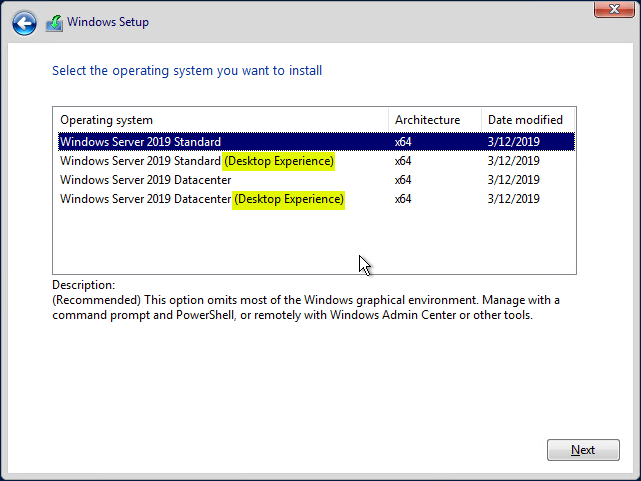
One time organizations get on board with Windows Server Core, information technology has many tremendous benefits.
However, its boring adoption tin be attributed to factors including the lack of comfort from an administrative standpoint in managing Windows Server Core installations. This can easily be overcome by administrators understanding and getting used to the available Server Core management tools.
Windows Server Cadre Management
Becoming accustomed to the management with Windows Server Core is central to successfully utilizing this powerful variant of Windows for immutable infrastructure, scripting, automation, etc. This has been the major deterrent amidst administrators who are used to managing Windows using the traditional Windows Server GUI. There are many tools and utilities that can exist used to successfully manage and maintain Windows Server Core.
Allow's take a look at the following tools:
- Remote PowerShell
- Sconfig
- Server Manager
- Remote Server Assistants Tools (RSAT)
- Windows Admin Center
Let'due south briefly look at the capabilities of each management tool and how information technology tin be utilized.
Managing Server Core with Remote PowerShell
PowerShell is the framework for automating Microsoft Windows Server. Basically, annihilation you can do in the Windows GUI, you can do with Windows PowerShell. It allows effectively automating Windows Server functions so tasks and provisioning tin be performed at scale when dozens or even hundreds of servers demand to be configured or provisioned.
With Windows Server 2019, upon first boot, you will exist prompted to modify your password of the local Ambassador business relationship. Dissimilar previous Windows Server Core releases, the default Sconfig application does non run (more on this utility later).
Using the Go-NetIPConfiguration cmdlet to get the current IP address information.
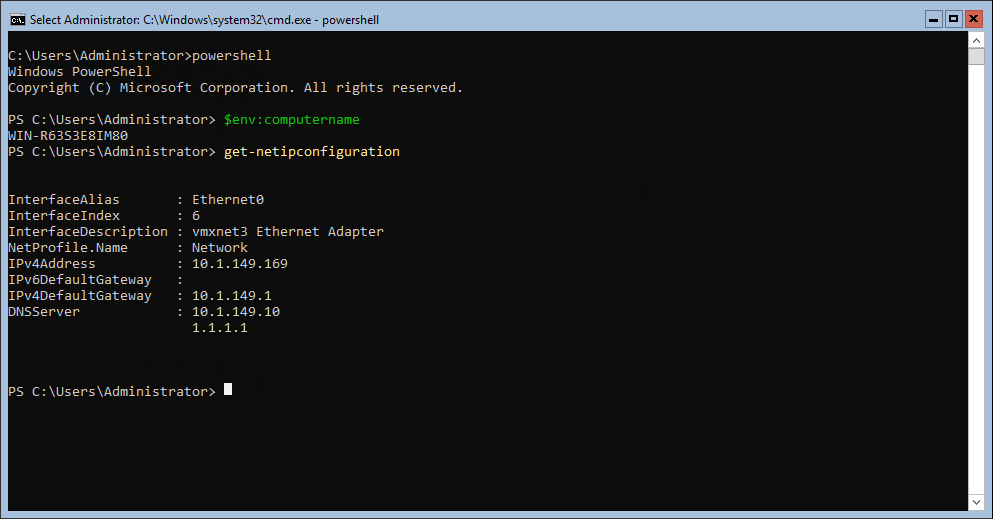
Just a quick example of having no GUI to piece of work with and effectively renaming your Windows Server 2019 Core server with the Rename-Computer cmdlet.
The heaven is the limit with PowerShell and using it for automating any of the configuration and deployment processes with Windows Server Core.
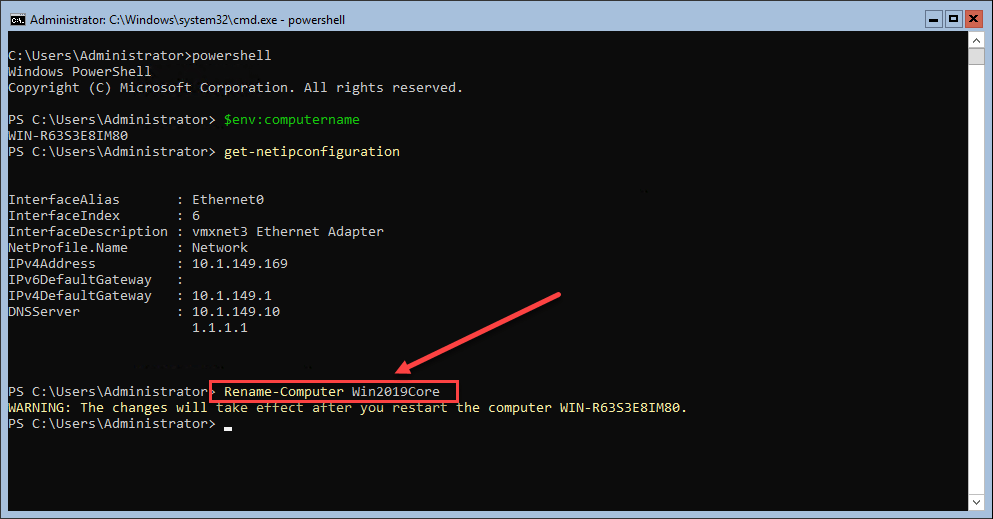
Sconfig
The Sconfig utility is the legacy utility for managing Windows Server Core installations since the very beginning with Windows Server 2008. Sconfig is still present in Windows Server 2019 Cadre installations, however, information technology is no longer launched by default which may indicate Microsoft's thinking on the future of the utility. It is still viable every bit a tool for use for at present.
To launch the Sconfig utility, simply type "sconfig" from the command line or PowerShell.

Managing Server Cadre with Server Manager
Like the Sconfig utility, Server Manager is more of a legacy utility for managing servers now with the introduction of the Windows Admin Center. Still, information technology is nevertheless a very viable solution for managing Windows Server Core installations. Simply add the Core Server via the Server Manager. With Server Director, you can manage many aspects of the Windows Server Core installation, including installation and removal of Roles & Features. To go to the Server Manager utility, y'all tin type servermanager.exe from a run or cmd window.
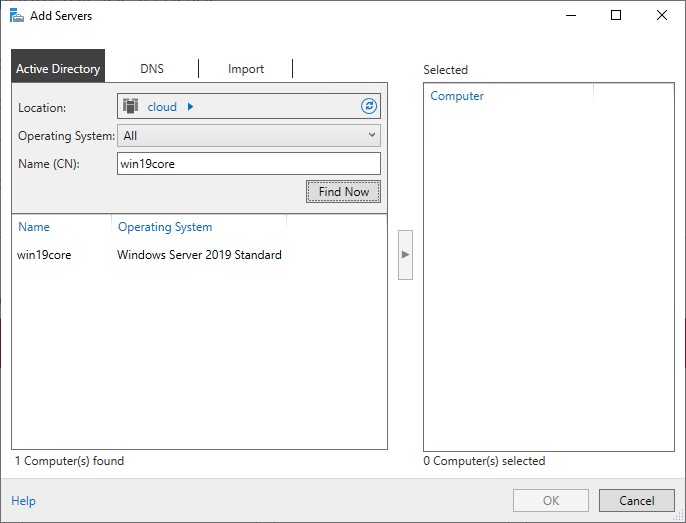
Managing Server Core with Remote Server Administration Tools (RSAT)
The Remote Server Administration Tools or RSAT allows installing the Windows Server direction tools on a client workstation that can then be used to manage both local and remote servers. RSAT is not a provisioning utility, only rather is the drove of server management consoles including Server Managing director that you are used to when logging into a GUI enabled server. The RSAT suite of consoles is readily available for download from Microsoft, depending on the version of Window 10 you are running, etc.
Managing Server Core with Windows Admin Heart
Windows Admin Center is the big news among managing Windows Server operating systems recently. Microsoft has engineered the new Windows Admin Eye as the manner forward for managing its Windows Server OS'es including Server Core.
Windows Admin Center is a web-based modern Windows Server management platform that is extensible and able to manage not only Windows Server and Server Cadre, simply also Windows HCI solutions like Storage Spaces Direct.
The Windows Admin Eye or WAC provides everything at your "fingertips" for direction and administration with the ability to perform many of the common types of administration tasks correct from the WAC console. Yous can also interact with PowerShell right from inside WAC.
Due to its web interface interaction, WAC can exist pulled up remotely via the Gateway Manner which is the default installation on Windows Server operating systems.
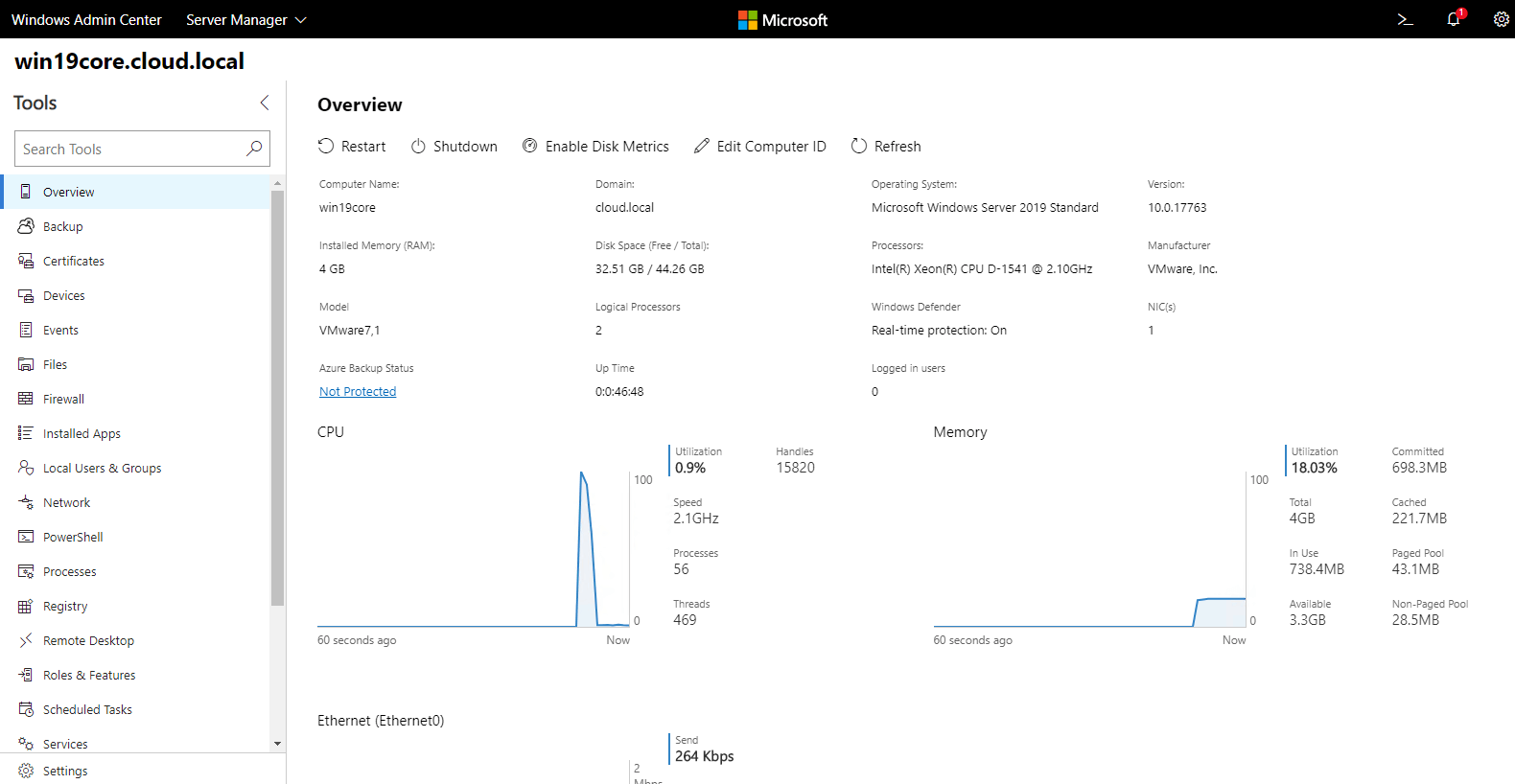
Windows Server Core Install Considerations
In Windows Server 2019, the installation of Server Core needs to exist determined alee of time and administrators must make sure of either a GUI or Server Core installation. Starting with Windows Server 2016 and higher, you can no longer alter between Server Core and the Desktop version of Windows Server, and then there is much more than finality in making that conclusion during the installation phase. This is certainly a consideration for installing Windows Server Core.
Additionally, becoming familiar with the direction tools ahead of time is a great manner for organizations to successfully utilize Windows Server core installations both on-bounds and in the public cloud.
Also, can Server Cadre exist used for anything? Non necessarily. The listing of supporting roles for Server Core contains the post-obit:
- Active Directory Certificate Services
- Active Directory Domain Services
- Agile Directory Federation Services
- Active Directory Lightweight Directory Services
- Agile Directory Rights Management Services
- Device Health Attestation
- DHCP Server
- DNS Server
- File Services
- Host Guardian Service
- Hyper-5
- Print and Document Services
- Remote Access
- Volume Activation Services
- Web Server (IIS)
- Windows Server Update Services
As an case, the following roles and role services are not in Windows Server Core:
- Fax
- MultiPointServerRole
- NPAS
- WDS
Role Services not in Server Core
- Print-Browse-Server
- Impress-Internet
- RDS-Gateway
- RDS-RD-Server
- RDS-Web-Access
- Web-Mgmt-Console
- Web-Lgcy-Mgmt-Console
- WDS-Deployment
- WDS-Transport (earlier Windows Server version 1803)
Determining if the service is available and supported for use with Server Core may determine whether it is an selection for a certain use case.
Concluding Thoughts
Windows Server Core is a powerful, lightweight, and capable version of Windows that is well-suited both on-premises and in the cloud.
It allows more than hands implementing automatic solutions at calibration and achieving the goal of immutable infrastructure. Managing and maintaining Server Core installations requires familiarity with the tools used to do so.
Equally shown in the mail, there are many utilities and tools that can be utilized to successfully manage the "headless" Server Core installation of Windows Server. It is much more than important with the latest Windows Server versions to make the correct conclusion on Server Core vs. Desktop edition as this can no longer be changed. Additionally, not every function is included or supported in Server Core installations.
Follow our Twitter and Facebook feeds for new releases, updates, insightful posts and more.
Source: https://www.vembu.com/blog/manage-windows-server-core/
Posted by: kellarbesillently.blogspot.com




0 Response to "How To Open Server Manager In Windows Server 2016 Core"
Post a Comment